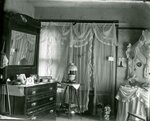
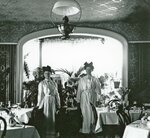
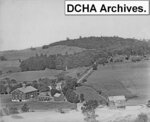

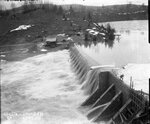
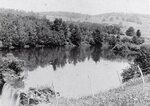
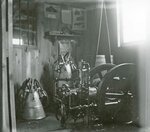
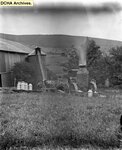
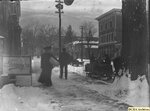
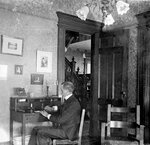
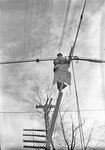
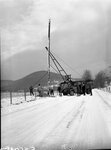
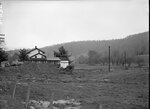
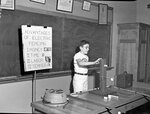
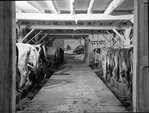
For thousands of years, human beings the world over relied on the rays of the sun and open fires to provide heating and light. Gradually, however, over the course of many centuries, lighting in homes and other buildings came to be provided by wax candles or oil and tallow lanterns.
In the final two decades of the nineteenth century, in Delaware County as elsewhere, kerosene lamps were introduced. Although messy and time-consuming in the sense that they had to be refilled and the glass chimneys cleaned on a regular basis, kerosene lamps were considered a great improvement over old- fashioned candles (image 1 & 2). Not only was kerosene used for lighting, but also to power stoves and even kerosene curling irons and refrigerators until well into the twentieth century.
Electricity would remain beyond the reach of most county residents until the final decade of the nineteenth century at the earliest. Ethel H. Bussey in her book History and Stories of Margaretville and Surrounding Area (1960), vividly describes the scene in Margaretville before the arrival of electric lighting:
The first streetlights in our village were similar to old lanterns on top of wooden posts on street corners. At dusk, Mr. Leslie DuMond, the village janitor for many years, would go about the village pulling a small wagon. In this was a large can of kerosene and a small three-step ladder. Mr. DuMond would put the ladder against the post, climb up, fill the lantern, and with matches light the light. It was a dim light but a bit better than pitch darkness on a moonless night.
At a later date, a gas corporation was formed and owned by a few of the village residents. Gaslights then replaced the old kerosene type. They were not the brilliant light of electricity today but were an improvement over the kerosene.
Electrification would come to the larger towns and cities in the United States before the sparsely populated countryside, and locally to the larger villages of Delaware County before the hamlets and remote farms.
One exception to this local pattern of development was the John T. McDonald farm on Elk Creek Road in the town of Meredith. The McDonald farm was one of the very first upstate New York farms to produce its own electricity. In the 1890s John T. acquired a dynamo, constructed a water wheel on the side of a barn adjacent to a dam on Elk Creek and ran electric lines to his milking barn, creamery and house. Hydro-electricity would supply the farm with lights and power until the mid-1930s (image 3).
In addition to a handful of other local farms and houses, some villages and hamlets produced their own hydro-electric power during the first decades of the twentieth century. For example, there existed at one time a “Treadwell Electric Light Pond,” an “East Sidney Electric Dam” and a “Deposit Electric Power House” (images 4, 5, 6).
The residents of East Branch in the town of Hancock also benefited from hydro power. They were able to purchase electricity generated by the waterwheel at the Treyz Dye Works in neighboring Cooks Falls until the 1940s. An old saying went that when a particularly heavy toad or fish was washed over the wheel, residents would notice brighter lights in their homes!
However, hydro-electricity, although clean and cheap, was unreliable. Low water in the dry summer months caused a drop in electrical production, sometimes to nil. The same was true during the long winter months when ponds, lakes and other waterways froze solid. And of course, sometimes too much water caused damaging floods which washed away hydro-electrical generation capabilities.
To combat this, some individual farms and houses, by the second decade of the twentieth century, could purchase Delco Light Plants to electrify their buildings (images 7, 8). Delco plants were introduced in 1916 and eventually the company became a subsidiary of General Motors. Delco plants had a set of batteries and a generator and were powered by gasoline or kerosene enabling individuals to light their homes or bring refrigeration to their businesses.
The community-wide electrification of some of the larger villages in Delaware County began in the late nineteenth century. Delhi, for example, introduced electric arc lights to parts of Main Street and in a few stores on Christmas Eve 1889 (image 9). Walton followed suit in early March of 1892 and Stamford in July 1892.
Electric illumination of this type in the business sections of the villages was provided by way of a generator in each village, and service remained sporadic until well into the following century. On numerous occasions a particular community generator would be out of service for long periods of time, forcing residents to revert to candles and kerosene, or, if they owned one, their individual Delco plants.
Indeed, it was not until the 1920s (and still later for some) that the main villages of the county could boast dependable 24-hour electric service (image 10). Margaretville, for example, did not receive regular electricity until 1924.
Meanwhile, reliable electric service to remoter regions of the county (and indeed the entire country) would not become available until the 1930s. This was, in part, due to economic factors working against setting up poles and stringing power lines over mountains, across fields and rivers and through forests. Simply put, for-profit power companies (such as NYS&G) were reluctant to expend the time, effort and money for lines serving only a handful of homes and farms.
Passage of President Franklin D. Roosevelt’s “Rural Electrification Act” (REA) of 1935 began the process of expanded rural electrification across the country, including bringing electricity to the more remote corners of the Catskills.
The Delaware Republican newspaper, May 13, 1936:
A number of electric light poles were hauled up Elk Creek on Saturday indicating that the electric extension into that farming section is soon to become a reality. Since the dam went out at the MacDonald farm last July, electricity has been a scarce commodity in that vicinity, but the power lines of the Associated Gas and Electric system will insure modern electrical conveniences along the four-mile length of the line. (image 11)
In 1941, the Delaware County Electric Association was established, quickly converting to a cooperative the following year. The cooperative applied for low-income loans in order to begin work on the infrastructure of a rural electrical supply system; however, World War II intervened and due to shortages in materials and manpower, it was not until June 1944 that the first rural homes and farms began to receive electricity. By March of 1945, 633 farms in the cooperative were electrified (images 12, 13).
Aside from the more obvious improvements in people’s homes (instant illumination with the flick of a switch, refrigeration & freezers, television, etc.), electrification brought the possibility of milking machines and bulk storage tanks to farms. The average dairy farmer could now increase the size of the herd and store the milk produced in refrigerated tanks in his own barn. What is more, farmers could now, at relatively low cost, string electric fences around the perimeters of their fields, ensuring their herds remained where they were supposed to be! (image 14)
However, electrification remained slow in reaching farms and service continued to be spotty until well after World War II. As late as 1950, one tenth of Delaware County farms were still not served by electricity (image 15).
Since then, of course, nearly every home and farm in the county has been connected to the grid and is now supplied directly by electricity (unless its residents are deliberately living “off-grid”). Although often unsightly, the wires and pylons that crisscross our region bring us the instant electricity we have all grown up with – and all expect. Only in those times of power outages do we get a glimpse of life as lived by our not-so-long-ago ancestors.